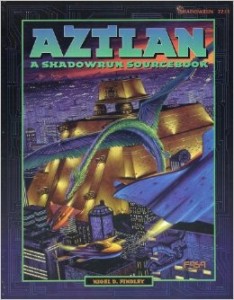One year ago, it was Day 10! And the topic for #RPGaDAY back then is your favorite tie-in novel or game fiction.
Oh gods.
Please, no.
I dislike most game fiction and haven’t read a tie-in novel for any game since maybe the Shadowrun 2 days. In my hazy recollections of game-based novels, it feels like one could hear dice clattering in the distance as the author tells you how awesome his character is, no really, he’s really awesome. Just look at him. He even had sex with the hot elf chick near the end of the book, how awesome is that? (Answer: really awesome.)
 Now, I love me some Shadowrun and I’ve always liked their books because they incorporated game fiction in a way that wasn’t just two to six pages of short stories. Most sourcebooks featured in-game information that was player-friendly, presented as files uploaded to a website, followed by a game rules section that showed how to use all that stuff in your game. The first section was full of ShadowTalk, comments on the actual datafiles you were reading, by other characters in the game world. There would be arguments, tangential discussions, and corrections of “facts†in the “real†datafile. There were recurring characters showing up in the sourcebooks, all with their own unique voices, style, and perspective on the articles mentioned. It actually made the game world feel larger.
Now, I love me some Shadowrun and I’ve always liked their books because they incorporated game fiction in a way that wasn’t just two to six pages of short stories. Most sourcebooks featured in-game information that was player-friendly, presented as files uploaded to a website, followed by a game rules section that showed how to use all that stuff in your game. The first section was full of ShadowTalk, comments on the actual datafiles you were reading, by other characters in the game world. There would be arguments, tangential discussions, and corrections of “facts†in the “real†datafile. There were recurring characters showing up in the sourcebooks, all with their own unique voices, style, and perspective on the articles mentioned. It actually made the game world feel larger.
A bonus: You didn’t have to sift through six different short stories and hit one or two whose writing style you absolutely hated.
The unique voices became lost in later years. By the time we reach 5th Edition, certain ShadowTalk comments read like the same author putting different names on the comments. It lost a bit of the magic. ((It also starts to seem like every commenter is someone’s Shadowrun character, which means they’re awesome and let me tell you why…))
But back in the SR2 era, there was the Aztlan sourcebook, which starts as a datafile about Azltan/Aztechnology that includes an entire secretly-recorded conversation cryptically commenting about that datafile in standard ShadowTalk format. But no, that is not the file you are reading. You were reading the leaked file with the secret cabal’s comments in it and everyone is now commenting on the datafile and the cabal’s conversation. Not only that, but some members of the secret cabal came to this leaked file and made their own comments about it.
It was amazing crazy nuts. There were so many clues to the ongoing metaplot (we were in the early 90s here) in that one sourcebook. So many answers. So many new questions. It was great.
But it wasn’t Bug City, which starts off with about fifteen pages of in-game material: chat room transcripts, photographs, and quarantine flyers.
>>>>>(Not everyone was paying attention, but this is how it started.)<<<<<
The first half of the book was all in-game information with lots of speculation, added notes, commentary, and stuff from a travel guide to Chicago from 2028, almost three decades ago. The actual game rules section starts on page 126. Tons of notes from inside the game world about what’s going on (and what people think is going on) for the first three quarters of the book. Bug City was immersive and amazingballs and I picked that sourcebook up from my local Hastings, not knowing anything about Shadowrun, and took it home and read the hell out of that thing and wound up getting into the whole bloody game.
So yeah, that’s great game fiction there.
Honorable Mention: Unknown Armies with her multi-page short story in the front of the book, handwritten I think, that really sets the mood for the game. But I didn’t buy nearly everything in the UA game line, so I’ve got to go with Bug City.
What about today, Thomas? Is Bug City still your favorite game fiction bit?
Oh gods, yes. I just went through the Universal Brotherhood handout that the players are supposed to read in the middle of Missing Blood, and man, the SR2 era was fantastic for that sort of stuff. I just did (am doing) layout work on three different RPGs that have in-universe artifacts in their books, and while they are neat ways to convey the feel of the game setting to the game’s players, none really come close to the ShadowTalk elements in those SR2 books. Those SR2 books are presented something like contemporary wikis, with their markup and discussion/talk pages. While it’s neat to see things like Dresden Files with post-it notes and handwritten things in the margins, it doesn’t feel as if you’re reading a printout of a conversation that just happened a few minutes ago. ((Especially with post-its and index cards printed in game books because those should logically be covering up something, right? So why can’t I move this card out of the way and see what’s underneath? There’s got to be something obscured.))
If I weren’t biased by having Bug City drawing me in, I’d go with Aztlan. It’s layers of neat stuff.
And if I had a copy of Graham Walmsley’s Stealing Cthulhu, I suspect it would be my favorite. That book’s all sorts of tricky.
